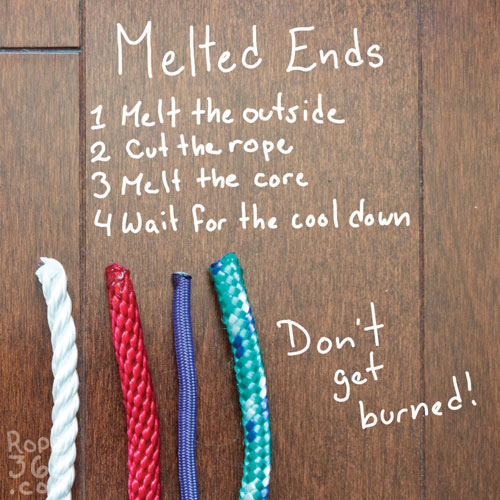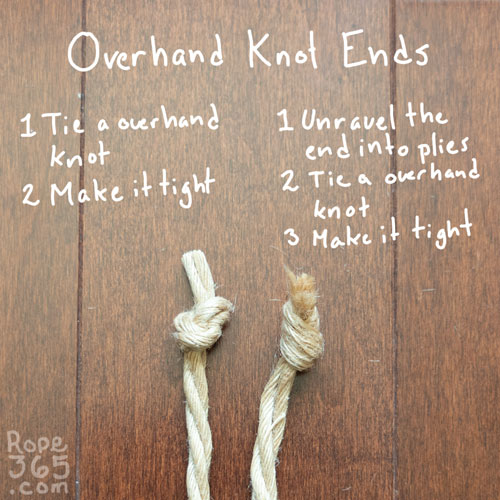Day 45: Ends
To prevent the rope from unravelling, the ends need to be tied up. There are different methods to finish the rope ends, our choice will depend on the type of rope we use, and on our preferences when it comes to tying techniques.
Rope Ends Techniques
Melting
If you use synthetic rope such as nylon or MFP, melting the rope is definitely the easiest way to end the rope. Just place the tip of the rope in a flame (lighter or similar device) and rotate it gently to melt the whole circumference. Protip – melt the rope before cutting it, then melt it again. Warning: avoid overcooking the rope, and be careful not to burn yourself from the tip or from plastic drips. This technique works only on synthetic fibre.
Whipping
You can use a thread and needle to sew the tip of the rope to create a whipping. The most common one is the sailmaker whipping but there are many designs. It is common to use colourful whipping to make a colour code (ex: identify rope size). It is common to combine whipping with other techniques.
Overhand Knots
Doing a simple overhand knot is a very quick way to end the rope. In order to make it more compact, you can untwist the rope before making the knot and use pliers to pull it very tight.
More Stopper Knots
There are several more complex knots that can be used to tie the end of a rope. Many are based around the crown knot (Day 18) because it works well with the three-stranded ropes. A crown knot itself won’t be solid enough to keep the rope from fraying, but there are a few knots based on its principles that can be used to make rope ending for three strands twisted ropes.
We will look at tips to tie these more complex ending knots and more variants in Day 221
More!
There are a few other ways to tie up the end of your rope. Shrinkwraps will create an effect similar to whipping, fast to make but not as strong as other methods. You can also look at rope splice to create different types of ending, there are a few interesting one like the eye splice that will create a loop at the end of your rope.
Comparing Ending Techniques
There are many criteria that we can look at to compare the different types of ending
Easy to maneuver – The slicker the end it, the easier it will be to pull the rope through. Rope with a more bulky ending tends to snag and will require more care when handling.
Easy to make – How much time and skills does it take to create this type of ending.
Solidity – Can this type of ending untie accidentally?
Easy untying for maintenance – As the rope age, we may want to undo the ending to adjust the tension between the strands. Knots can be untied, whipping needs to be redone, and melted rope must be cut.
Extension speed – The first technique learned in Day 5 requires knots at the end of the rope. If you already have knots tied on your rope, you can extend rope really quickly, otherwise you will need to add knots or use an alternate technique.
Ending tuck – As we learned on Day 4, you can tuck the end of your ropes more easily with knotted ends to allow for a cleaner look and avoid dangling ends.
Types of rope – Not all techniques work on all types of ropes, melting the rope is only possible with material that melts, knots will hold better on rope with more grip.

Video Tutorial
Activate subtitles or transcript to view instructions. Please like and subscribe to support the channel. Also available on Vimeo thanks to our patrons on Patreon.
Practice Time!
Try different rope endings and take notes on what you liked and didn’t like in each.
Exploration ideas
- Try burning the tip of different rope to see what melts and what doesn’t.
- Try different materials to tie whipping.
- Compare the size of different types of knots.
- Try making knots more compact by using plyers or dipping the end of the rope in water.
- Make a set of rope with each rope ended differently, try tying and untying with it for a while.
Inspirations and Resources
- Rope Ends by The Dutchy
- Notes on whipping rope by ben_not_solo
- How to Tie a Sailmaker’s Whipping by Troop Leader
- Compact overhand stopper knot video by The_Link
- Sailmaker’s Whipping video by Johnny Debt
- Sailmaker’s Whipping by Animated Knot
- Thistle knot by Dorian Meshaw
Credit: R/P: Ebi McKnotty
Or return to The Rope for more options.





Leave a Reply